CHCECE013 Use of Child Information to Inform Practice - Assessment 2
VerifiedAdded on 2023/06/07
|5
|823
|168
Homework Assignment
AI Summary
This CHCECE013 Assessment 2 solution focuses on using information about children to inform practice. It includes an anecdotal record detailing observations of a child's strengths and weaknesses in play and social interaction, along with learning stories and jottings. The solution also addresses program planning, suggesting playful activities and mental tasks to enhance a two-year-old's motor skills and cognitive abilities, as well as the use of art for color understanding. Furthermore, it discusses gathering information about the child through secondary sources, such as family members, and reflections from staff and nurses, emphasizing the importance of a comprehensive approach to child development and care. Desklib provides this and other solved assignments for students.
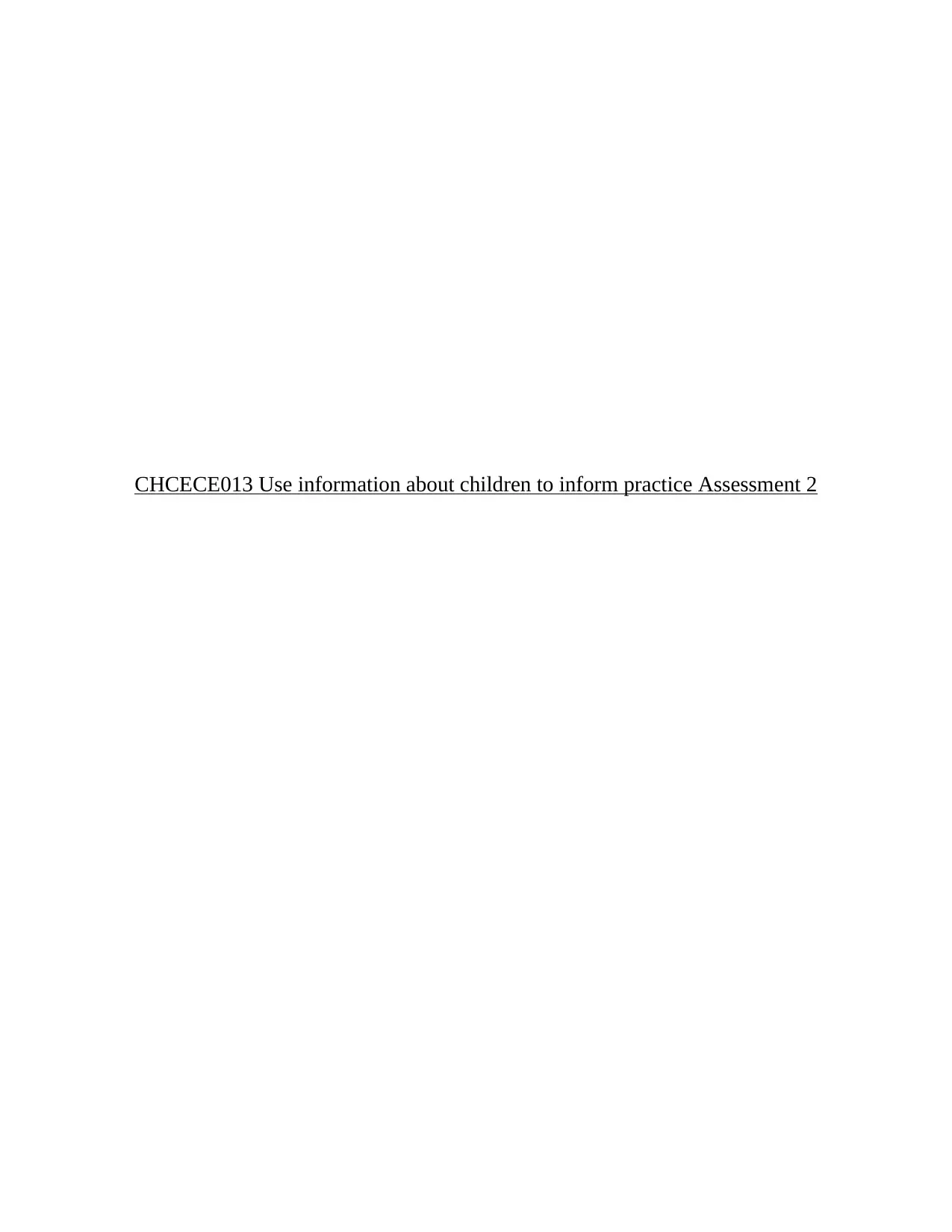
CHCECE013 Use information about children to inform practice Assessment 2
Paraphrase This Document
Need a fresh take? Get an instant paraphrase of this document with our AI Paraphraser
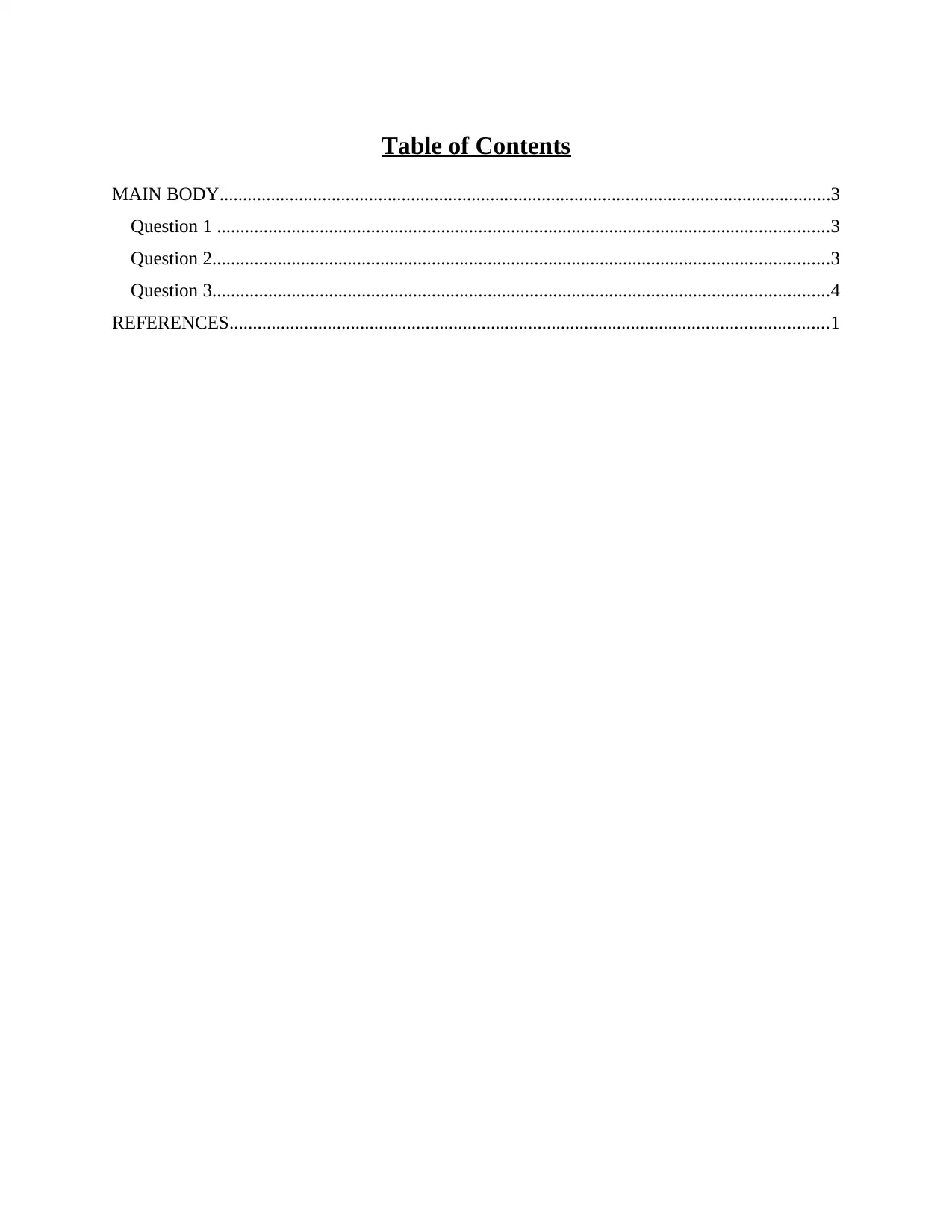
Table of Contents
MAIN BODY...................................................................................................................................3
Question 1 ...................................................................................................................................3
Question 2....................................................................................................................................3
Question 3....................................................................................................................................4
REFERENCES................................................................................................................................1
MAIN BODY...................................................................................................................................3
Question 1 ...................................................................................................................................3
Question 2....................................................................................................................................3
Question 3....................................................................................................................................4
REFERENCES................................................................................................................................1
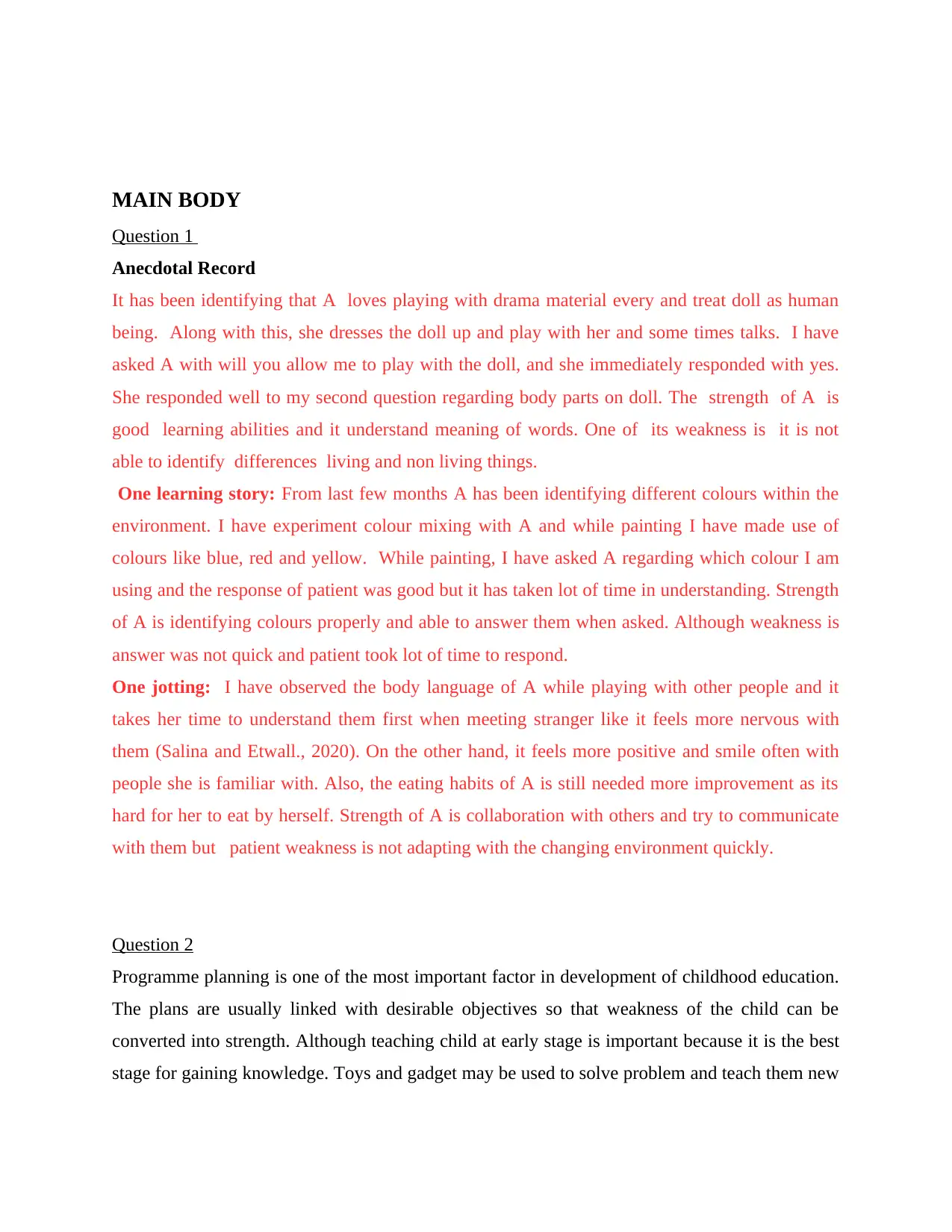
MAIN BODY
Question 1
Anecdotal Record
It has been identifying that A loves playing with drama material every and treat doll as human
being. Along with this, she dresses the doll up and play with her and some times talks. I have
asked A with will you allow me to play with the doll, and she immediately responded with yes.
She responded well to my second question regarding body parts on doll. The strength of A is
good learning abilities and it understand meaning of words. One of its weakness is it is not
able to identify differences living and non living things.
One learning story: From last few months A has been identifying different colours within the
environment. I have experiment colour mixing with A and while painting I have made use of
colours like blue, red and yellow. While painting, I have asked A regarding which colour I am
using and the response of patient was good but it has taken lot of time in understanding. Strength
of A is identifying colours properly and able to answer them when asked. Although weakness is
answer was not quick and patient took lot of time to respond.
One jotting: I have observed the body language of A while playing with other people and it
takes her time to understand them first when meeting stranger like it feels more nervous with
them (Salina and Etwall., 2020). On the other hand, it feels more positive and smile often with
people she is familiar with. Also, the eating habits of A is still needed more improvement as its
hard for her to eat by herself. Strength of A is collaboration with others and try to communicate
with them but patient weakness is not adapting with the changing environment quickly.
Question 2
Programme planning is one of the most important factor in development of childhood education.
The plans are usually linked with desirable objectives so that weakness of the child can be
converted into strength. Although teaching child at early stage is important because it is the best
stage for gaining knowledge. Toys and gadget may be used to solve problem and teach them new
Question 1
Anecdotal Record
It has been identifying that A loves playing with drama material every and treat doll as human
being. Along with this, she dresses the doll up and play with her and some times talks. I have
asked A with will you allow me to play with the doll, and she immediately responded with yes.
She responded well to my second question regarding body parts on doll. The strength of A is
good learning abilities and it understand meaning of words. One of its weakness is it is not
able to identify differences living and non living things.
One learning story: From last few months A has been identifying different colours within the
environment. I have experiment colour mixing with A and while painting I have made use of
colours like blue, red and yellow. While painting, I have asked A regarding which colour I am
using and the response of patient was good but it has taken lot of time in understanding. Strength
of A is identifying colours properly and able to answer them when asked. Although weakness is
answer was not quick and patient took lot of time to respond.
One jotting: I have observed the body language of A while playing with other people and it
takes her time to understand them first when meeting stranger like it feels more nervous with
them (Salina and Etwall., 2020). On the other hand, it feels more positive and smile often with
people she is familiar with. Also, the eating habits of A is still needed more improvement as its
hard for her to eat by herself. Strength of A is collaboration with others and try to communicate
with them but patient weakness is not adapting with the changing environment quickly.
Question 2
Programme planning is one of the most important factor in development of childhood education.
The plans are usually linked with desirable objectives so that weakness of the child can be
converted into strength. Although teaching child at early stage is important because it is the best
stage for gaining knowledge. Toys and gadget may be used to solve problem and teach them new
⊘ This is a preview!⊘
Do you want full access?
Subscribe today to unlock all pages.

Trusted by 1+ million students worldwide
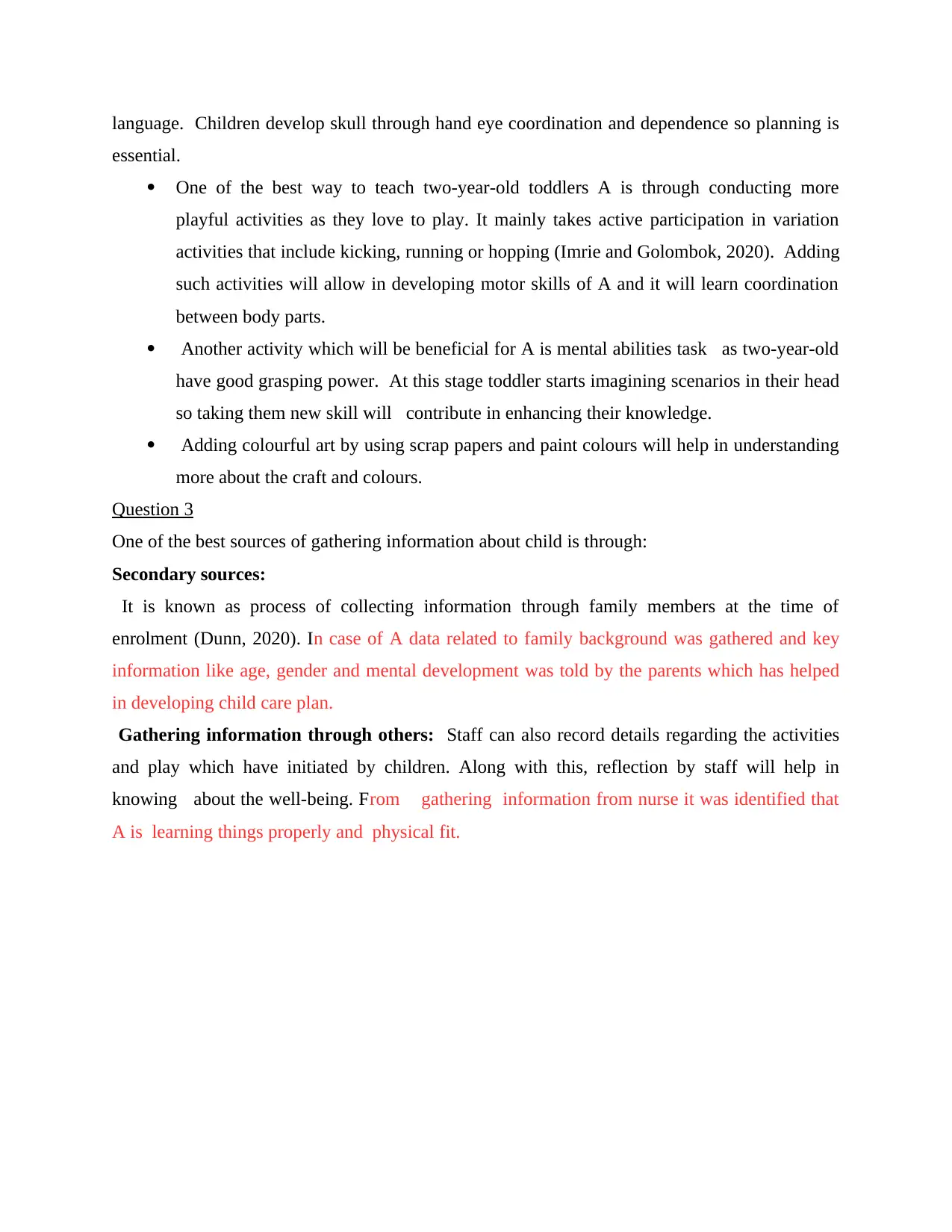
language. Children develop skull through hand eye coordination and dependence so planning is
essential.
One of the best way to teach two-year-old toddlers A is through conducting more
playful activities as they love to play. It mainly takes active participation in variation
activities that include kicking, running or hopping (Imrie and Golombok, 2020). Adding
such activities will allow in developing motor skills of A and it will learn coordination
between body parts.
Another activity which will be beneficial for A is mental abilities task as two-year-old
have good grasping power. At this stage toddler starts imagining scenarios in their head
so taking them new skill will contribute in enhancing their knowledge.
Adding colourful art by using scrap papers and paint colours will help in understanding
more about the craft and colours.
Question 3
One of the best sources of gathering information about child is through:
Secondary sources:
It is known as process of collecting information through family members at the time of
enrolment (Dunn, 2020). In case of A data related to family background was gathered and key
information like age, gender and mental development was told by the parents which has helped
in developing child care plan.
Gathering information through others: Staff can also record details regarding the activities
and play which have initiated by children. Along with this, reflection by staff will help in
knowing about the well-being. From gathering information from nurse it was identified that
A is learning things properly and physical fit.
essential.
One of the best way to teach two-year-old toddlers A is through conducting more
playful activities as they love to play. It mainly takes active participation in variation
activities that include kicking, running or hopping (Imrie and Golombok, 2020). Adding
such activities will allow in developing motor skills of A and it will learn coordination
between body parts.
Another activity which will be beneficial for A is mental abilities task as two-year-old
have good grasping power. At this stage toddler starts imagining scenarios in their head
so taking them new skill will contribute in enhancing their knowledge.
Adding colourful art by using scrap papers and paint colours will help in understanding
more about the craft and colours.
Question 3
One of the best sources of gathering information about child is through:
Secondary sources:
It is known as process of collecting information through family members at the time of
enrolment (Dunn, 2020). In case of A data related to family background was gathered and key
information like age, gender and mental development was told by the parents which has helped
in developing child care plan.
Gathering information through others: Staff can also record details regarding the activities
and play which have initiated by children. Along with this, reflection by staff will help in
knowing about the well-being. From gathering information from nurse it was identified that
A is learning things properly and physical fit.
Paraphrase This Document
Need a fresh take? Get an instant paraphrase of this document with our AI Paraphraser
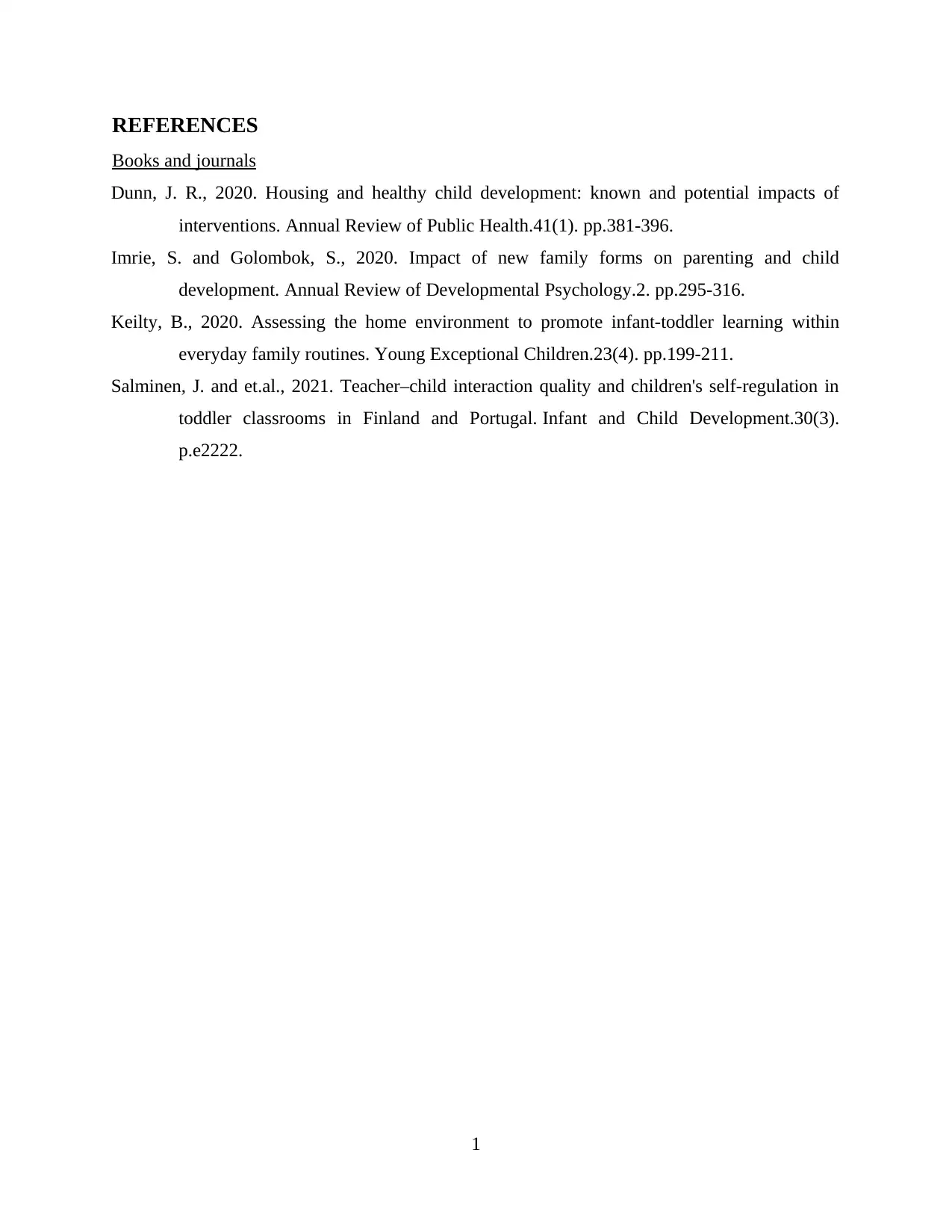
REFERENCES
Books and journals
Dunn, J. R., 2020. Housing and healthy child development: known and potential impacts of
interventions. Annual Review of Public Health.41(1). pp.381-396.
Imrie, S. and Golombok, S., 2020. Impact of new family forms on parenting and child
development. Annual Review of Developmental Psychology.2. pp.295-316.
Keilty, B., 2020. Assessing the home environment to promote infant-toddler learning within
everyday family routines. Young Exceptional Children.23(4). pp.199-211.
Salminen, J. and et.al., 2021. Teacher–child interaction quality and children's self‐regulation in
toddler classrooms in Finland and Portugal. Infant and Child Development.30(3).
p.e2222.
1
Books and journals
Dunn, J. R., 2020. Housing and healthy child development: known and potential impacts of
interventions. Annual Review of Public Health.41(1). pp.381-396.
Imrie, S. and Golombok, S., 2020. Impact of new family forms on parenting and child
development. Annual Review of Developmental Psychology.2. pp.295-316.
Keilty, B., 2020. Assessing the home environment to promote infant-toddler learning within
everyday family routines. Young Exceptional Children.23(4). pp.199-211.
Salminen, J. and et.al., 2021. Teacher–child interaction quality and children's self‐regulation in
toddler classrooms in Finland and Portugal. Infant and Child Development.30(3).
p.e2222.
1
1 out of 5
Related Documents
Your All-in-One AI-Powered Toolkit for Academic Success.
+13062052269
info@desklib.com
Available 24*7 on WhatsApp / Email
![[object Object]](/_next/static/media/star-bottom.7253800d.svg)
Unlock your academic potential
Copyright © 2020–2025 A2Z Services. All Rights Reserved. Developed and managed by ZUCOL.





